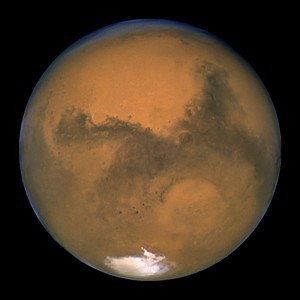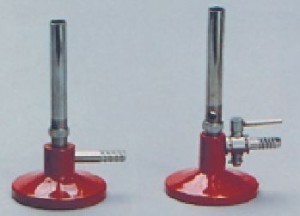Mars Size
In terms of equatorial radius, the size of Mars is 3,396.2 km, or  nearly half the Earth. The polar radius is 3,376.2 km. The total surface area is 144,798,500 km2.
nearly half the Earth. The polar radius is 3,376.2 km. The total surface area is 144,798,500 km2.
Physical Characteristics of Mars
Its volume is 1.6318 × 1011 km3, equal to 0.151 Earths. The mass is 6.4185 × 1023 kg. The equatorial surface gravity is 3.711 m/s² and has an escape velocity of 5.027 km/s. The mean surface temperature is -46 C. The minimum is -87 C and the maximum is -5 C. The sidereal rotation period is 24.622 9 hours. The equatorial rotation velocity is 868 km/h
The Atmosphere
It is composed of 95.32% carbon dioxide, 2.7% nitrogen, 0.13% oxygen, 210 ppm water vapor, 1.6% argon and 0.08% carbon monoxide. A study of the size of Mars will show other elements present in the atmosphere. These include neon, krypton, xenon, ozone, metha, hydrogen peroxide and formaldehyde.
Orbital Specifications
The perihelion is 206,669,000 km (1.381 497 AU) and the aphelion is 249,209,300 km (1.665 861 AU). The orbital period is 686.971 day. The synodic period is 2.135 Julian years (779.96 day). It has two satellites, Phobos and Deimos.
General Description
Mars is the fourth nearest planet to the Sun. It is nicknamed the Red Planet due to its reddish appearance. This is due to the presence of iron oxide all over the landscape.
Named after the Roman god of war, Mars possesses a thin atmosphere. There are craters, volcanoes, polar ice caps and numerous mountains. The planet’s seasonal cycle is like those of Earth.
While the size of Mars is smaller compared to Earth, it has the highest mountain in the Solar System, Olympus Mons. Its Valles Marineris is the biggest canyon in the Solar System too. Another notable feature is the Borealis basin. This coves nearly 65% of the planet.
Satellites
Mars’ two satellites, Phobos and Deimos, both orbit very near the planet. Both have highly unusual shapes. The prevailing theory is that the two satellites were asteroids that got trapped in the planet’s orbit.
Phobos can be seen rising in the west and setting at the east. The rising and setting takes only 11 hours. Deimos also emerges in the east, but it takes nearly three days to set on the west. Research shows their composition is similar to asteroids.
Water on Mars
While Mars is now geologically inactive, scientists believe that Mars once had plenty of water on its surface. Research indicates that geysers may have flown in decades past. Information gathered in 2005 revealed the presence of water ice in the poles. On July 31 2008, the Phoenix Lander sampled the water ice.
Distance from Earth
Despite the small size of Mars, it can be seen with the naked eye. Its average distance from Earth is 78 million km. However it can get as near as 57 million km.
Scientific explorations continue to take place in and around Mars. The question of whether life existed there in the past is still uncertain. While the planet is geologically dead today, it may have been more hospitable for life in the past.





